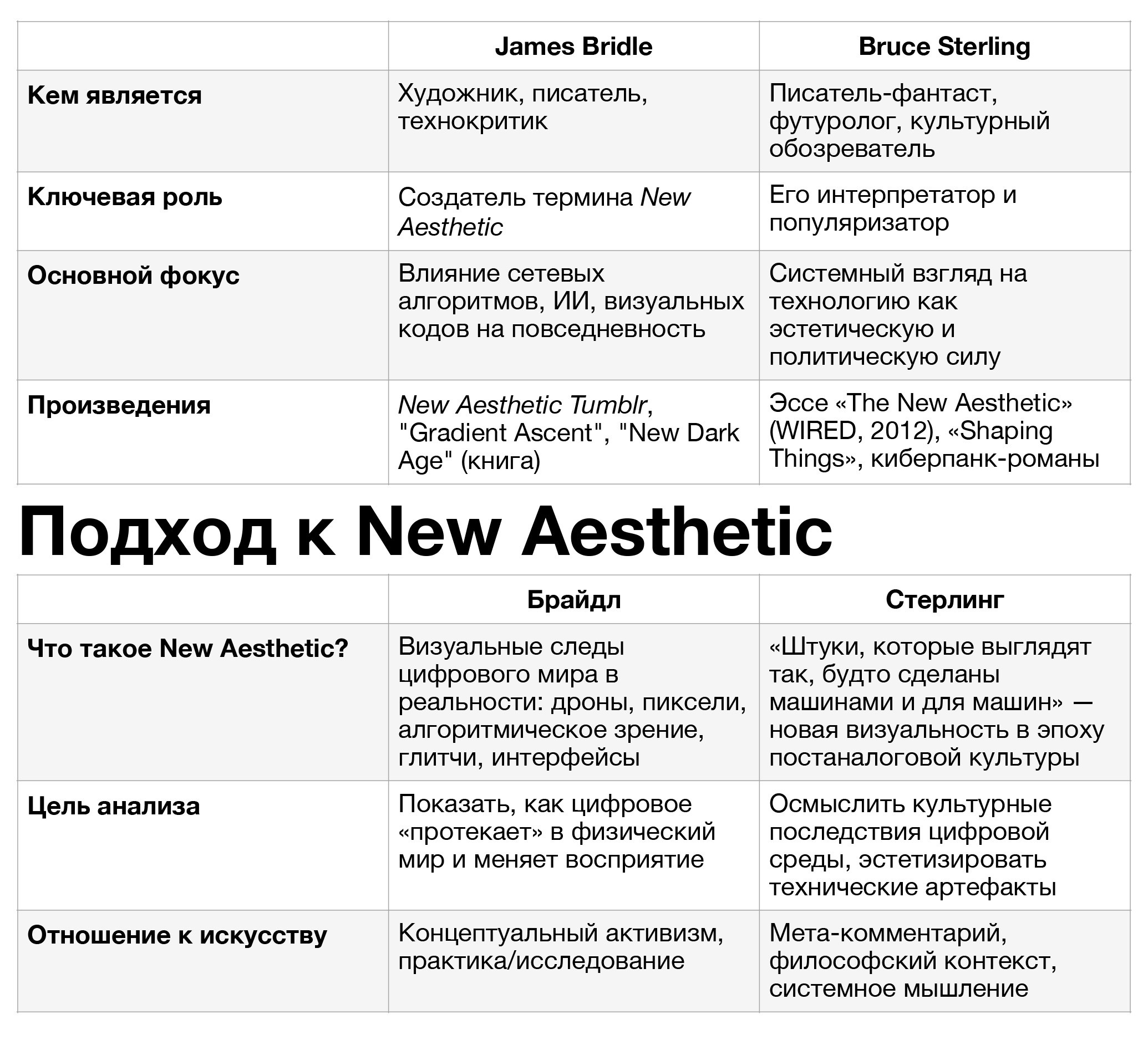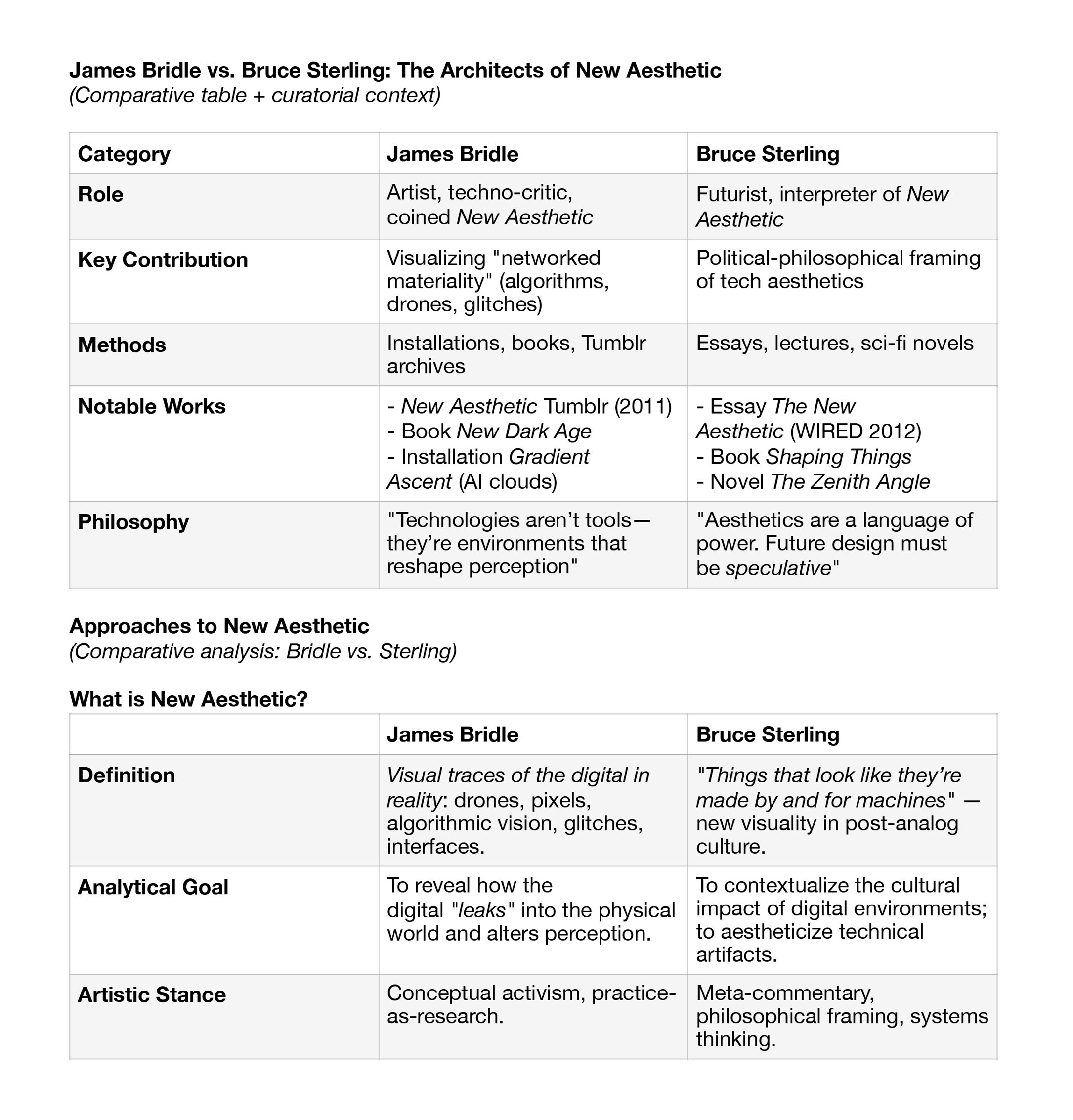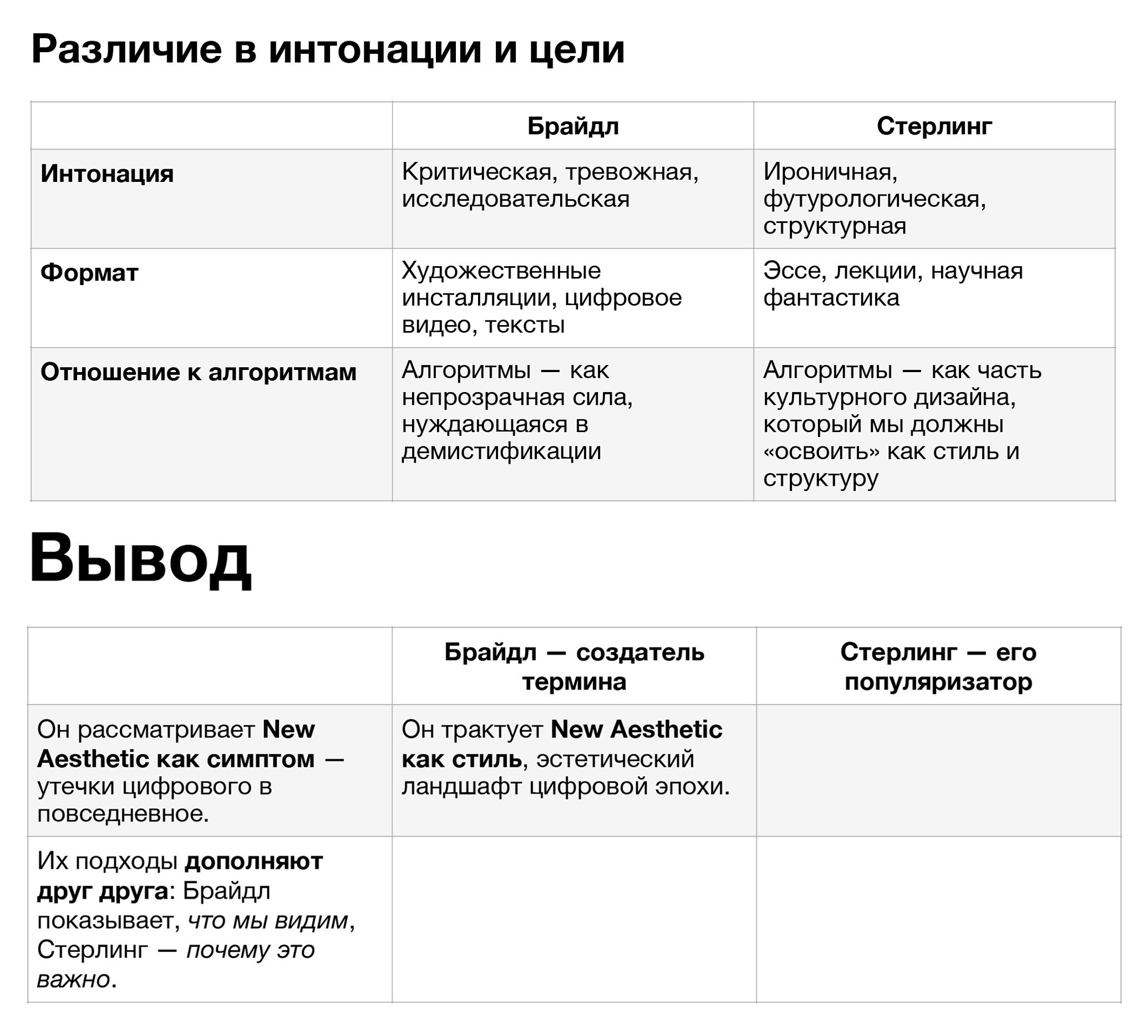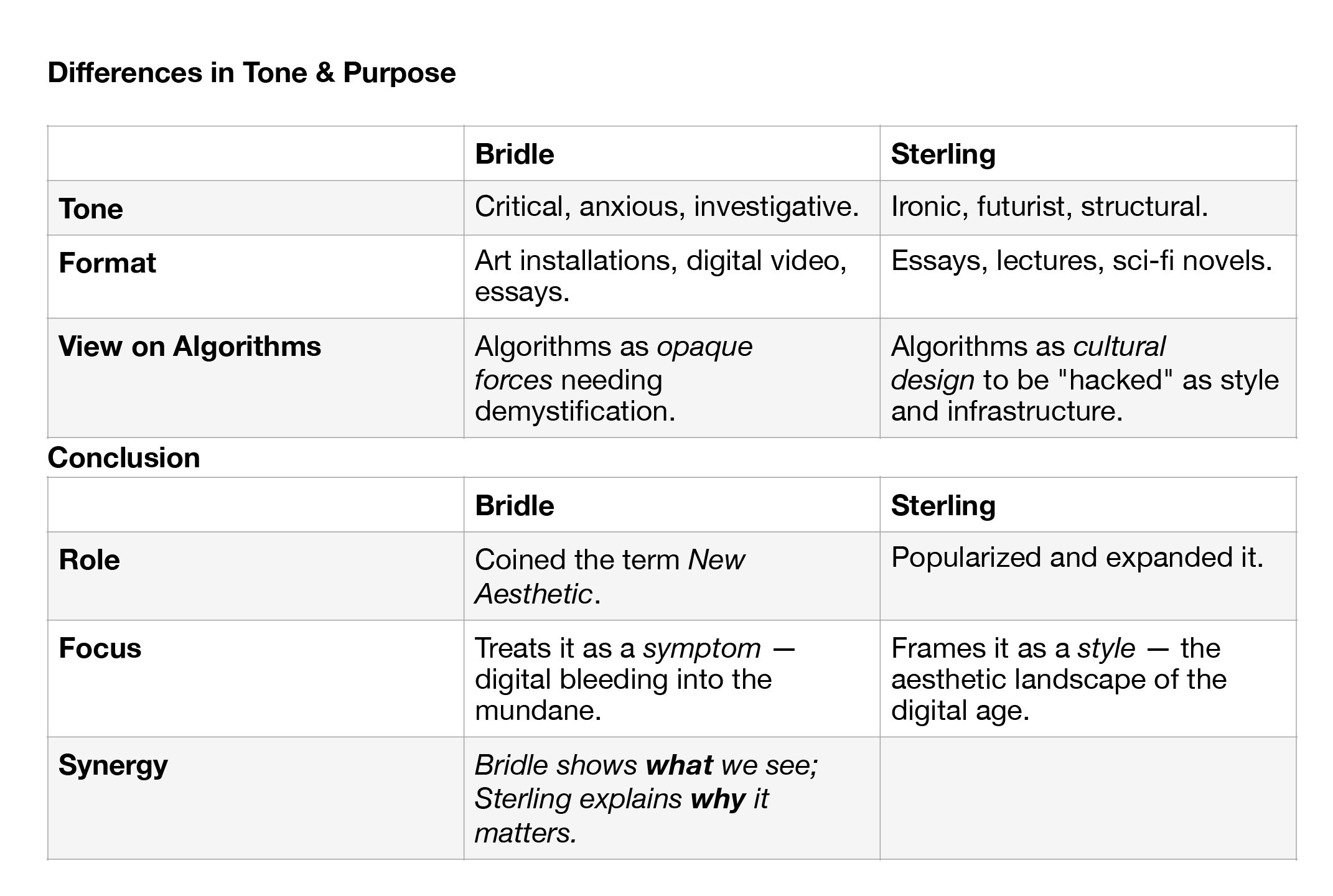Post-Y2K / Web 1.0 Aesthetic
Origins: Late 1990s — early 2000s
Visuals:
- Glitches, Arial and Comic Sans fonts
- 3D buttons, window interfaces, gradients
- Old website aesthetics (GeoCities, XP, ICQ)
Why It’s Back: - Nostalgia for the pre-algorithmic internet
- Young artists exploring the “visual innocence of early digital culture”
- Anti-UX: The appeal of “ugly but alive” aesthetics
Examples: - Emi Kusano — Inspired by retro-futurism and AI-era Web 1.0, creates digital works and metaverse installations (e.g., Mars House NFT).
- New Aesthetics movement — Theorized by James Bridle and Bruce Sterling, explores the collision of digital and physical worlds.
Michael Paraskos — Key Figure in New Aesthetics
Biography & Career
- Born in 1969, Leeds, UK.
- PhD from the University of Nottingham, specializing in Herbert Read’s aesthetics.
- Taught at Leeds, Hull, and Nottingham; Senior Lecturer at Imperial College and City & Guilds of London Art School; Visiting Professor at York St John University.
Themes & Concepts
- Art historian, critic, and novelist.
- Focuses on anarchism in art, critiques conceptualism, advocates for New Aesthetics—art emphasizing materiality and physical interaction.
Publications
- Herbert Read: Art and Idealism (2014)
- Four Essays on Art and Anarchism (2015)
- Clive Head (2010)
- The Table Top Schools of Art (2008) — Key text on New Aesthetics.
- Novels: In Search of Sixpence (2016), Barfrestone (2024).
The New Aesthetics Project
- Developed the theory of material-focused art, opposing sterile conceptualism.
- Collaborated with painter Clive Head (e.g., The Prague Project, 2003), promoting art that engages with physical time/space perception.
Who is it?




VHS / Grunge / Pseudo-documentary look
Origin: 1980s–1990s
Appearance:
- Film grain, paparazzi flash, crops, and noise
- Analog-style footage with intentional “errors” (errors are the style)
- Graphics resembling VHS cassette recordings
Why It’s Back: - Trust in “raw” visuals
- Sense of presence or archival reality
- Protest against the sterile perfection of AI-generated art
Examples:
Contemporary art photographers and video installations (e.g., Christelle Oyiri) use grain effects and deliberate “rawness” as a reactive form of aesthetic expression.
- Andy Denzler — Swiss artist creating oil portraits with visual “smears” and distortions, mimicking a VHS pause during rewind, evoking a frozen, gritty moment.
- Sarah Zucker — American video and digital artist (aka The Sarah Show), blending modern tech with analog VHS effects, a pioneer in crypto art using these visuals as NFTs.
- Nick Gentry — British artist working with physical media like vinyl records, cassettes, VHS tapes, and floppy disks, creating portraits where analog objects become eyes and textures, a metaphor for technological and visual archives.
- Gregor Hildebrandt — German artist adhering magnetic tapes and cassettes to canvases, sometimes constructing installations from thousands of cassettes, translating sound into visual volumes and flipping through aesthetic memory.
- Charlotte Clermont — Video and photo artist using old VHS and security cameras, creating images with grain, noise, and wear, resembling an “archive of the future.”
vimeo.com/956 500 590? share=copy
Sadie Benning — Pioneer of PixelVision (a children’s video camera using audio cassettes), their early video diaries, spanning nearly three decades, resemble a grunge archive exploring intimacy, gender, and identity.
Mungo Thomson — Creates conceptual objects and installations using material imprints of time: rolodexes, magazines, Super-16mm films, like “freeze-frames of history” in physical form.
Jacolby Satterwhite — Combines personal VHS memories (e.g., childhood music videos) with contemporary digital club aesthetics in VR/video installations, a hybrid of family tapes and futuristic visuals.
Christelle Oyiri (aka Crystallmess) — Works in VHS/grunge/pseudo-documentary aesthetics: christelleoyiri.com/
Collective Amnesia: In Memory of Logobi (2018–2022)
~15-min HD video using found footage, 3D animation, and archival clips of Logobi street and dance videos from Abidjan and Paris.
Visuals: Grain filters, layered textures, resembling “analog memory” in digital form.
Family Fresco 2002 (2022)
Installation of an “unfolded screen” panel with manipulated family photos: faces partially erased, eyes glowing red, creating a pseudo-documentary, unsettling effect.
The archive becomes a distorted memory of the Ivory Coast’s conflict era.
VENOM VOYAGE (2023)
Installation as “dark tourism” in a travel-agency format: nostalgia for tropical islands clashes with chronicles of pollution and colonial aftermath.
Scenes mimic travel VHS footage with an anxious retouch.
HYPERFATE, FASTER THAN THIS IS SUICIDE (2023)
Video and performances with grainy VHS style, blending narrative, bold glitches, and the expressive energy of a nightclub experience.
Evokes a sense of hyperspeed events, a storm of sound and imagery, reminiscent of a “VHS club.”
Why Oyiri’s Work Exemplifies VHS/Grunge/Pseudo-Doc Art:
Material: Found tapes, old family photos, and analog formats transformed into digital memory objects.
Visual Tactics: Grain, noise, blurriness, and overexposure create an “uncontrolled frame”, akin to a spontaneous archive.
Emotional Resonance: Anxiety, memory, and postcolonial context feel like found footage “not meant to be public.”
Anti‑design / Brutalism
Origins: Early internet, Bauhaus + 90s
Visual Style:
- Oversized fonts, minimal CSS, system default colors
- Gridless layouts, uncomfortable UI
- Raw compositions, often “ugly”
Why It’s Back:
- Backlash against Instagram-perfect aesthetics
- Trend toward “visual honesty”
- Emphasis on concept over polish
Examples:
- Artists’ regenerative websites use brutalist UI — awkward grids, bold system fonts.
- Regina Frank’s installations blend textiles with interactivity, breaking conventional UX.
David Rudnick
- Style: Digital brutalism, anti-grid typography, dystopian visuals.
- Known For: Album covers (Ye, Evian Christ), Trax Magazine redesign.
- Key Work: “Post-Capitalist” poster series.
Jürg Lehni
- Style: Anti-perfectionist, mechanical brutalism, hacked design tools.
- Known For: Hektor spray-paint robot, Scriptographer (defunct Adobe plugin).
- Key Work: “VVork” (collaborative anti-design platform).
Experimental Jetset
- Style: Deconstructed modernism, punk-inspired typography.
- Known For: Whitney Museum identity, “Full Scale False Scale” posters.
- Key Work: “SMCS (Socialist Modernist Concrete Sculptures)”.
- Web-site
Zack Rosebrugh (Zack Dog)
- Style: Web brutalism, glitch art, broken UX.
- Known For: “Cyberbrokers” NFT project, “This Website is a Protest”.
- Key Work: “Club Internet” (anti-design collective).
Loraine Furter
- Style: Feminist brutalism, DIY publishing, hacked systems.
- Known For: “Fcking Good Art”* zine, “Hybrid Publishing” research.
- Key Work: “Post-Digital Publishing Archive”.
Honorable Mentions:
- Vasjen Katro (Baugasm — psychedelic brutalism).
- Ludovic Balland (Typography of Protest — anarchic layouts).
- Kyle Berger (Brutalist web design, “The Outline” former design director).
Need deeper dives into any of these artists’ techniques or portfolios? Let me know!
For inspiration:
- Follow Brutalist Websites
- Explore Anti-Design Fest (defunct but archived).
Collage / Cut‑out / DIY‑aesthetic
Origins: 20th-century avant-garde, 1960s, 70s punk
Visual Style:
- Paper cutouts, crooked compositions
- Digital collages with deliberately crude layouts
- Magazine-like, sketchbook, or manifesto aesthetic
Why It’s Back:
- Revival of the tactile and material
- Post-pandemic urge to “create with hands”
- A tool for critiquing capitalism (see: transaction art)
Examples:
- Sonia Gomes — transforms recycled fabrics into raw, organic forms, where material becomes an “aesthetic transaction”
- Carla Arocha & Stéphane Schraenen — large mirrored installations where objects lose function and gain visual value
- Transaction Art — materials “give” their past (linens, furniture, wrappers), viewers “pay” with attention and meaning. This exchange creates aesthetic value and critiques consumerism.
Archivism / “Memory of the Future”
Origin: 1970s conceptualism, flyers, zines, documentary aesthetics
Appearance:
- Infographics from the past
- PowerPoint 2003 aesthetic
- Artistic projects presented as files, archives, or diagrams
Why It’s Back:
- We live in an era of distrust of information
- Artists create “fictional archaeologies”
- Documentary formats gain artistic value
Examples:
Conceptual media artists working with archives, infographics, and PowerPoint formats.
-
Tino Sehgal (performance): Transactions occur not through objects but through agreements—an oral contract between artist and viewer.
Transaction Art: Interstice between body, word, and gaze; the viewer receives a real, non-virtual experience, with perceptions recorded as the “temporal value” of the event.
American Artists
- Trevor Paglen
Style: Analyzes surveillance systems through data visualization, using government archives and satellite imagery.
Works:
- From “Apple” to “Anomaly” (translating classified CIA terms into infographics).
- The Last Pictures (a digital archive on a golden disc launched into space).
- IG
2. Janice Kerbel
- Style: Pseudo-bureaucratic projects (e.g., audio guides for nonexistent places).
- Key Work: DOUG (a nine-part musical composition for six voices, commissioned by The Common Guild and first performed on May 1, 2014, in the Jeffrey Room, Mitchell Library, Glasgow). The work narrates the story of a fictional character, Doug, who endures a series of tragicomic catastrophes (bear attack, lightning strike, slipping on a banana peel). Nominated for the Turner Prize 2015, the composition employs classical musical forms with a “raw” and absurd logic, making it an example of anti-design. The absence of a public recording highlights its ephemerality, while accompanying silkscreen prints visually represent the score through typography, further enhancing its brutalist aesthetic.
- Website
3. Seth Price
- Style: Deconstruction of digital archives and advertising imagery.
- Works: Redistribution — collages made from pirated film copies and PowerPoint slides.
4. Lawrence Abu Hamdan
- Specificity: Analysis of audio archives (e.g., interrogation recordings) through visualization.
- Project: Earwitness Theatre — infographics of sonic violence.
European Artists:
-
Harun Farocki (Germany)
- Style: Essayistic films using archival materials (e.g., surveillance footage).
- Work: Parallel I–IV — exploration of CGI graphics in early computer games.
-
Mette Sterre (Netherlands)
- Specificity: Absurd bureaucratic performances incorporating Excel spreadsheets.
- Project: The Department of Non-Human Office Affairs — a parody of corporate language.
-
Joana Hadjithomas (Lebanon/France)
- Style: Works with digital spam and archives of fake news.
- Work: Wonder Beirut — collages made from damaged war photographs.
-
Rafael Rozendaal (Netherlands)
- Specificity: Web art mimicking early internet interfaces (e.g., Abstract Browsing — websites as abstract paintings).
-
Cristina De Middel (Spain)
- Style: Fictional archival projects (e.g., The Afronauts — fake documentation of Zambia’s space program).
Key Themes of Their Works:
- Dematerialization of Power: How PowerPoint and Excel become tools of control.
- Archives as Propaganda: Who decides what is preserved in digital memory?
- Poetry of Data: Transforming mundane spreadsheets into art.
Where to See Them:
- Exhibitions: ZKM (Germany), Rhizome (New York).
-
Online: UbuWeb (Media Art Archives).
Harun Farocki — Cinema, Video Games and Finding the Detail
A video installation exploring the intersections of cinema and video games through a raw, minimalistic aesthetic aligned with anti-design and digital brutalism, focusing on the details of digital worlds and their cultural significance.
Kidcore & Naive Art / Children’s Visual Language
Origin: Children’s books, drawings, Bauhaus schools
Appearance:
- Hand-drawn, naive style, bright colors, repetitive shapes
- Aesthetics resembling “drawn by a child”
- Use of plasticine, markers, chalk
Why It’s Relevant:
- Escape from anxiety: Like adult coloring books.
- Critique of systems: A childlike perspective exposes societal absurdities (e.g., in Borremans’ work).
- Heavy themes: War depicted through “plasticine” soldiers in Henrot’s art.
Where to See It:
- Outsider Art Fair (New York/Paris)
- LaM Museum (Lille) — naive art collection
Examples:
“Rebellion Against Adulthood”
- Theme: How artists use childlike aesthetics to critique society.
Artists:
- Mark Gonzales (USA) — Doodles as a protest against commercial art.
- Camille Henrot (France) — Plasticine chaos vs. digital perfectionism.
- Michaël Borremans (Belgium) — “Innocent” portraits with political subtext.
Lesson Format:
- Offline: Installation with chalkboards where viewers add their thoughts.
- Online: Instagram filters transforming photos into “childlike drawings.”
“Healing Through Naivety”
Theme: Art as therapy for anxiety.
Artists:
- Margaret Kilgallen (USA) — Hand-drawn fonts reminiscent of children’s diaries.
- Christine Sun Kim (USA) — Chalk-drawn soundwaves for stress relief.
- Judith Scott (USA) — Textile sculptures created by an artist with Down syndrome.
Lesson Format:
- Workshops with finger painting for adults.
- VR exhibition “Doodle Room” (drawing in the air).
“Dark Fairytales”
Theme: Childlike style for adult themes (war, ecology).
Artists:
- Pavel Pepperstein (Russia/Germany) — Cartoonish characters in apocalyptic landscapes.
- Laura Owens (USA) — “Cute” paintings with hidden political symbols.
- Michaël Borremans (Belgium) — Dolls with empty eyes as metaphors for violence.
Lesson Format:
- Animation in the style of Soviet diapositive films with dark narratives.
- Zine with illustrations “Scary Stories for Grown-Up Kids.”
“Materials of Childhood”
Theme: Nostalgia for tactility (plasticine, markers, crayons).
Artists:
- Camille Henrot (France) — Stop-motion with plasticine.
-
Jordan Wolfson (USA) — Animatronic dolls with “childlike” faces.
- Style: Provocative media art blending animatronics, childlike aesthetics, and digital violence. Wolfson uses “childlike” visual codes (cartoonish faces, bright colors) to address trauma, aggression, and digital dehumanization, resembling nightmarish 90s toys.
- Philippe Greissien (France) — Giant crayon sculptures.
Lesson Format:
- Interactive zone: Sculpting with smart plasticine (changes color with hand warmth).
- Exhibition “Markers vs. AI” — hand-drawn paintings over neural network art.
“Kidcore as Meme Culture”
Theme: Influence of internet memes on naive art.
Artists:
- Harald Glööckler (Germany) — “Bad” digital collages in the spirit of early internet.
- Rosa Menkman (Netherlands) — Glitch art mimicking children’s drawings in MS Paint.
- Anna Rotenberg (USA) — NFTs with characters resembling MS WordArt.
Lesson Format:
- Telegram channel with daily “meme-masterpieces” by artists.
- Exhibition “Error 404: Childhood Not Found” — glitched screens with hand-drawn doodles.
- Book: Zine Crayon Manifesto with essays on why adults should draw with their fingers.
Camp / 80s Ornament & Memphis Revival
Origin: Memphis Group, camp culture
Appearance:
- Geometric patterns, vibrant colors, glossy surfaces
- Ornament as a means of resisting utilitarian thinking
- Decorativeness as a philosophy
Why It’s Back:
- As a political statement
- As anti-capitalist irony
- As a reaction to “smart” and dull design
Artists:
Ettore Sottsass (Italy, 1917–2007)
- Style: Founder of the Memphis Group, pioneer of postmodernism, combined geometric shapes, bright colors, and plastic laminates to create a “kitschy” aesthetic that rejects functionalism. His works, such as the Carlton bookshelf (1981), use asymmetry and eccentric patterns as a protest against “boring” modernism.
Camille Walala (France/UK, b. 1977)
- Style: Modern interpretation of Memphis Revival, blending geometric patterns, vibrant neon and pastel colors, and elements of op-art and South African Ndebele patterns. Her street murals and installations embody anti-capitalist irony, celebrating joy and individuality.
Nathalie Du Pasquier (France/Italy, b. 1957)
- Style: Member of the Memphis Group, known for textile patterns and paintings combining bright colors, geometric shapes, and kitschy motifs. Her works emphasize decorativeness as a philosophy, rejecting utilitarianism.
Michele De Lucchi (Italy, b. 1951)
- Style: Member of the Memphis Group, known for combining functional objects with absurd forms and vibrant colors, creating furniture that resembles art. His works serve as an ironic commentary on capitalist rationality.
Adam Nathaniel Furman (UK, b. 1982)
- Style: Contemporary designer inspired by Memphis, using bright colors, glossy surfaces, and geometric patterns to create interiors and objects that celebrate “excess” and kitsch as a protest against minimalism and capitalist “dullness.”
Lesson Format:
- #UglyBeautiful challenge — posting photos in an 80s style with the hashtag.
- Zine Ornament is Not a Crime — a manifesto featuring artists’ essays.
- Generative website where patterns are created from stock market data.
Where to See It:
- Design Miami/Basel fair
- Vitra Design Museum exhibitions (Germany)
Where to See Their Influence:
- Transmediale (Berlin) — digital culture biennale.
- Ars Electronica (Linz) — art/tech festival.
Course: “For Beginners and Those Confused by Contemporary Art”
Want to understand contemporary art and the avant-garde? I invite you to individual lessons — lectures as part of the original course “For Beginners and Those Confused by Contemporary Art.”
Lectures, drawing, discussions about cartoons, and exhibitions—no cramming or boredom.
🍷 No notebooks—you’ll remember everything naturally
🎬 Cinema + art + practice
“Here, we’ll loudly sip tea and gossip about art.”












































